Trees: Assets or Obstacles?
By Pamela Pan (潘美玲)
Photos by Tzu Cheng Liu (劉子正)
Abridged and translated by Syharn Shen (沈思含)
Trees: Assets or Obstacles?
By Pamela Pan (潘美玲)
Photos by Tzu Cheng Liu (劉子正)
Abridged and translated
by Syharn Shen (沈思含)
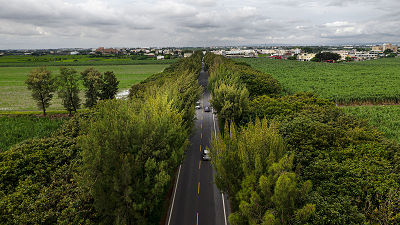
On County Road No. 143 in Zhanghua County, there is the only tree tunnel in Taiwan formed of Australian pine trees. Planted during the Japanese occupation, the trees not only block the coastal winds and sand, but also lower temperatures, provide fresh air, and offer breath-taking views along the road.
It is mid-August, and beside an Earth God temple by Inner-Mountain Highway passing through Kaohsiung's Liugui in southern Taiwan, stands a 163-year-old guest tree. Pink flowers are blooming on the evergreen tree, reminding passersby that autumn is just around the corner.
Roads lined with trees are charming, but some people see trees as obstacles to rural development, claiming that they take up space on roads that need to be widened.
In March 2017, over 100 old mango trees by a one-kilometer section on Provincial Highway No. 27 were poisoned. Large quantities of leaves withered, turned brown, and the mango trees died. This incident made news all over Taiwan. But, why were the innocent trees poisoned to death?
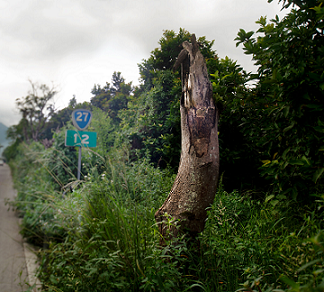
A mango tree by Provincial Highway No. 27 has lost all of its branches and foliage after being poisoned. It is one of the over 100 mango trees along the highway that were poisoned by those who saw them as obstacles to widening the highway and developing the local economy.
An ongoing struggle for space
There has been a long-standing struggle for space between trees and rural dwellers in townships all over Taiwan, and the poisoning of the old mango trees in Liugui is a case that reflects this struggle.
Provincial Highway No. 27 is the narrowest of all provincial highways in Taiwan—with 4.5 to 6 meters wide. Twenty years ago, local councilors and landowners had already wanted to cut off the mango trees by the highway to widen the road. Its spur route Provincial Highway No. 27a, after being devastated by Typhoon Morakot in 2009, has been rebuilt and widened into a four-lane highway. Provincial Highway No. 27, on the other hand, has remained the same, lined with over 300 mango trees that are nearly 50 years old. Were the mango trees poisoned to death because they were standing in the way of widening the highway?
"To create wealth, we need to rebuild and widen our roads first." "If the trees are not moved away to give space for wider roads, there will be no rural development." "Building roads equals progress and development." These statements show the mentality of many living in the rural areas of Taiwan. While an ideal picture for rural development may differ from one person to another, it all comes down to the debate of "who are the local people?" and "who gets to decide how a road will look like?" Apart from landowners and residents of the area, can users of the road, and even the general public, have a say on the matter?
Having worked to protect the mango trees of Liugui, executive director of Meinong Field Learning Association Wen Zhong-liang (溫仲良) expressed that road development and tree preservation don't necessarily counter each other. It is possible to have both. Wen said that if the dispute remains between "developers" and "conservationists," with both sides labeling each other as "radical activists detached from the realities of life" or "self-interested profit seekers," everybody loses in the end. Opposing viewpoints divides society, builds up resentment, and true progress is further hampered.
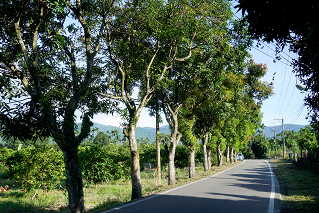
Over 300 mango trees lined on Provincial Highway No. 27 are part of the shared memory of the local people in Liugui.
What do visitors want to see when they come to Liugui? Do people just pass by on their way to another destination? When a place has beautiful scenery, visitors will come. So, what if old trees were part of the local landscape?
Wen illustrated his point with an example from his hometown Meinong, famous for its rural charm and Hakka culture. "Twenty years ago when Meinong was undergoing urban planning, the first thing people wanted to demolish was the Meinong East Gate Tower. It's hard to believe, right? Who on earth had the guts to tear down the most important cultural heritage for the local people?!" But at the time, this was the way of thinking for the majority of people in Taiwan. Rural development required the set up of an industrial park that symbolized economic development, and the first and foremost step was to remove all obstacles in sight to build a wide and straight road. No one would have foreseen that the East Gate Tower and Meinong Lake—both salvaged back then—would become not only the pride of the local people, but also must-see historic sites that attract visitors and bring in tourism revenues.
The value of old mango trees
What is the value of the old mango trees for the local people in Liugui?
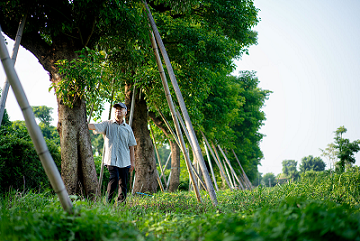
Huang Tiao-zan stands by the mango tree that his father, Huang Jin-huang, successfully bred a new mango variety 53 years ago.
A 71-year-old local resident remembers having planted these mango trees when little. "It was a mandatory service in Liugui. Each household had to send a person to plant trees along the roads. These mango trees carry shared memories of the local people. They should not be thoughtlessly removed! It only takes a swing to chop down a tree, but it takes decades for one to grow."
Still, local councilors have other thoughts in mind. "Common and ordinary, the mango trees are not worth keeping, and they only bring hassle and inconvenience to the locals." "What's all the fuss? They are just mango trees!"
But, are they really just mango trees?
In fact, mangoes are central to Liugui's history and cultural identity. The district is the hometown of Huang Jin-huang (黃金煌), a farmer who bred a new mango variety popular in Taiwan. Visiting Huang's home, his son stood by the tree that successfully bred the mango cultivar 53 years ago. "In 1966, my father 'gave birth' to the Jin-huang mango. In the same year, I was also born," said Huang's son with a smile. The new and popular cultivar brought economic prosperity to Liugui, and farmers who used to grow rice, sugar canes, and other crops started to grow mangoes instead. Huang only finished elementary school, but his achievement earned him prestigious prizes from the Council of Agriculture and Taiwan Society for Horticultural Science.
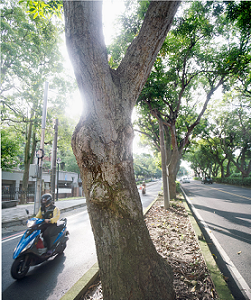
The 100-year-old old mango trees near the entrance to National Chung Cheng University are unique local features, but with concerns about road safety, there has been a plan to move the trees.
A rural district situated near the mountain areas in southern Taiwan, Liugui developed from the logging and camphor industries. With only around 12,000 residents, the area has a rustic air and simple character, featuring Laonong River and the Eighteen Arhats Mountain Scenic Area as well-known local landscapes. What values can the old mango trees on Provincial Highway No. 27 bring to the area?
Wang Li-ping (王力平), a nature observer invited to Liugui to investigate on the local environment, noted some exciting discoveries on the highway where the mango trees stood. "In only two days, I have recorded nearly 28 kinds of birds, including five protected species and two endemic species of Taiwan. I even saw four rare and valuable birds—maroon orioles! During my observations at night, I've also found 12 different kinds of frogs within a distance of two kilometers." Wang also saw large quantities of Pyrrosia adnascens—a species of fern—growing on the trunks of the old mango trees. These ferns offer shelter to many common house geckos that would come out at night and prey on small insects. A small ecosystem was growing among the mango trees on the highway.
There was a happy ending for everyone in Liugui's case. Provincial Highway No. 27 went through a widening project that preserved the old mango trees and kept the road’s natural surroundings, with its spur route Provincial Highway No. 21a running parallel it on the other side of Laonong River providing fast and convenient transportation.
Wen expressed that when Provincial Highway No. 27 becomes a scenic road surrounded by nature, with the old trees living in peace on it, can people truly see and appreciate the value of the road and the trees.
Do trees need to give way to roads?
Another two rows of mango trees in Jiayi, lined on the road before the entrance of National Chung Cheng University (NCCU), are over 100 years old and in danger of being relocated.
The local county government hopes to carry out a development project that involves widening the road and moving the mango trees elsewhere. There were no pre-assessment reports, and the reasons stated for the relocation of the trees were road safety and the falling of mango fruits which may injure passersby. "Transplanting damages the trees and the survival rate is less than 50%. If not carefully carried out, the relocation of the trees could mean the killing of them," said Guan Zhong-xiang (管中祥), a professor at NCCU's Department of Communication who gathered students and local residents to form an alliance to help preserve the old trees.
Those in favor of widening the road and relocating the trees focus on road safety issues, saying that the trees block drivers' line of sight. But, there is no assessment from a long-term analysis of the road’s traffic accidents to support this argument.
Kuo Po-Sheng (郭博勝), graduate of NCCU, thinks that widening roads is not the only option as there are many ways to solve transportation issues. Having served as an environmental planner at a construction consultant company, Kuo cares for the mango trees at his alma mater and has come up with some solutions after analyzing traffic data on the road. “In fact, improvement measures are only needed in some sections of the road, such as accident-prone intersections. Shrubs that may block drivers' line of sight can be trimmed, an area on the road can be marked for turning cars, and road markings and traffic signs can be added. With proper design and management, the road safety issues that the local government pointed out can be solved.”
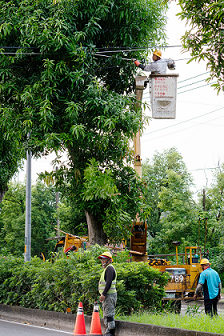
Regular pruning of the trees can increase road safety and promote the health of trees.
In Taiwan, many provincial highways and county roads are lined with mango trees. According to research conducted by Huang Jian-zhi (黃建智) and others, the planting of mango trees may be related to Emperor Hirohito of Japan. Taiwan was under Japanese rule at the time, and to celebrate Hirohito's ascension to the throne in 1928, it was ordered the planting of tropical trees that he loved on the North-South Highway, or today's Provincial Highway No. 1.
Chief executive of a community in Jiayi's Mingxiong Township Li Ming-zhu (李銘柱) also expressed that the mango trees had military purposes, as the crowns of mango trees are wide enough to cover military tanks. A map of the area indeed shows many locations and sites of military importance, including a secret base for Kamikaze planes that conducted suicide attacks for the Empire of Japan.
During the Japanese occupation of Taiwan between 1895 and 1945, many roads from Yunlin to Tainan in southern Taiwan had fruit trees planted on both sides of the road. Taking County Road No. 167 in Jiayi's Lucao Township for example, the local township each year closes a section of the road for people to harvest mangoes and learn to make green mango pickles. This not only solves the seasonal problem of falling fruits injuring passersby on the road but also brings the local community together.
The alliance to protect the mango trees at NCCU, together with local residents in nearby communities, has also held a mango festival. An elementary school teacher who came to take part in the event shared her thoughts. "Whether the mango trees will be preserved in the end or not, at least we have promoted environmental protection and let more people know the old trees’ historical and cultural values. If a struggle for space between humans and trees reappear in the future, I hope our next generation can make wiser decisions."
Refreshing green canopies
The famous Taiwanese poet Wu Sheng has been protecting trees throughout his life. He said tree tunnels were once all over Taiwan, but as the economy took off and the island underwent modernization, trees were ruthlessly removed in the name of development.
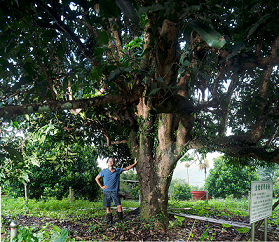
A long-time advocate of the protection of trees, poet Wu Sheng cares for the trees originally on County Road No. 152. The trees have been moved to a park.
Why do trees exist and what is their value to human beings? Wu said that during hot summer afternoons in the rural areas of the early days, the shade under the trees was the most popular spot for local residents to gather and chat. But as electric fans and air conditioners became popular, people no longer appreciated trees and even started to complain about their inconveniences. Trees create falling leaves that have to be swept away every day. They obstruct the line of sight and are thus not good for feng shui. Their shade blocks sunshine necessary for cultivated plants and negatively impacts the harvest. Since when have trees, once a central part of people's lives, suddenly become bothersome?
Shih Yueh-ying (施月英), Secretary-General of the Environmental Protection Union at Zhanghua County stated that there are very few tree tunnels left in the south of the county. In recent years, a petrochemical investment project, an industrial park construction plan, and a science park development plan have all targeted nearby county roads for widening projects. Old bishop wood trees and Australian pine trees that were originally planted by the roads have already been uprooted and removed. "With today's extreme weather conditions, it is already not enough to plant trees. So, how would people still want to cut trees and carelessly move them around? From my observations of the roads' usage, it was absolutely unnecessary to remove the trees!" Shih expressed with concern.
Due to the science park development plan in Zhanghua's Erling Township, about 180 old bishop wood trees—aged 30 to 50 years old standing by County Road No. 152—were to be removed. There is nothing wrong with development, but it should not be carried out ruthlessly or without considering the environment. Wu hopes for a win-win situation and has suggested the county government to preserve the old trees while expanding the roads on both sides of the trees. He also suggested designating separate lanes for cars, scooters, and bicycles. After much communication, the construction company has finally agreed to Wu's suggestion, but in the end, it was the opposition from the local legislators that brought everything back to the starting point. The trees were to be removed as originally planned.
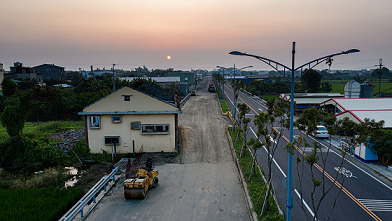
County Road No. 152 was widened to meet the needs of an industrial park in Zhanghua County's Dacheng Township. After the construction of the industrial park was halted, the road was still widened as planned, removing the large and evergreen camphor trees originally on both sides of the road. The traffic flow on the widened road did not increase as much as expected.
Local journalist Yan Hong-jun (顏宏駿) showed us a photo of a old bishop wood tree that stood on the road before being removed. The thick crown of the old tree was extended into the air, creating a large, green canopy. Just by looking at the photo, one could already feel a pleasant breeze and cooling fresh air. At the site where the old bishop wood tree once stood, the widened county road is now bare with layers of dust blown in the air under the scorching sun, and the thin and newly planted Michelia compressa trees stand feebly in the middle of the road on a traffic island that is less than 2 meters wide.
We gave up old trees that took four decades to grow, in exchange for a wide and bare concrete road that offers 10 seconds less of driving time.
Learning from roads in other places
In Taiwan, the majority of the people see building and expanding roads as beneficial to the development of a place. Both councilors and legislators are keen in proposing road development plans as they see these projects as political achievements that can diminish the differences in development between the urban and rural areas.
Wu Sheng stated that many people living in rural areas think that as long as there are development projects with money invested, it means that the government is caring for them and their land. When roads are built or widened to become large, straight, and smooth, people think progress will come. The mindset of "speed brings efficiency and development" is prevalent in the counties and townships of Taiwan, which results in more places covered in concrete. The design of roads then serves only one single purpose—the transportation of cars. Speed becomes the most important standard, and when one can drive fast on a road smooth without any traffic, then it is considered a "good" road.
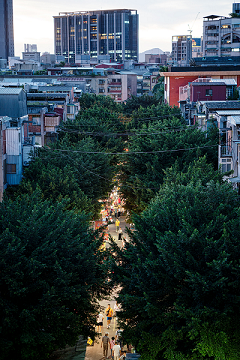
Growing along a street by Nanjichang Night Market in Taipei, Chinese banyan trees form an integral part of people's lives.
Taiwan's construction industry is heavily influenced by the American mindset of road development. The U.S. has vast expanses of land, with many roads as wide as 30 meters offering two-way traffic and four to six lanes. Is the American standard of wide, straight, and fast roads truly applicable to Taiwan?
The design of roads in Europe, on the other hand, follows a different approach. Chen Yu-ping (陳郁屏), CEO of Taiwan Ecological Engineering Development Foundation (EEF), said that in the UK, there are few two-way roads and interchanges on highways. Rather than seen as marks of progress, these constructions are viewed as potential intruders of an area's original landscape. What the general public care about is whether natural forests and streams will be invaded by roads and disturbed by car noises.
Having studied in London, Chen shared her observations. "The roads in the UK are generally not very wide or straight and may be narrow and curvy, but it is because of this that drivers are much more careful. Drivers on the roads have eye contact with one another and do not simply speed by." There, personal convenience over public interest is not a common way of thinking.
"Located in a subtropical zone, Taiwan normally has very hot weather, so trees on the roads are important for the environment as well as road users. Old trees can even become an asset for local development," said the honorary chairman of EEF Ho Chen Tan (賀陳旦). While Ho Chen Tan was serving as Taiwan's Minister of Transportation and Communications, he decided that landscape design would be the priority in the widening project of a section of Provincial Highway No. 9. Liu Po-Hong (劉柏宏), principal of Classic Design and Planning that was responsible for the design of the widening project, said that with the then-Minister's support, their team could prioritize natural landscapes into the road design, preserving 3,629 trees that were spanned over 69 kilometers of the road. In addition, the design of the trees' height on both sides of the road decreased the number of sparrows killed by cars. The design and working principles of the road section has won the "outstanding award" at the 6th Taiwan Landscape Architecture Award in 2019.
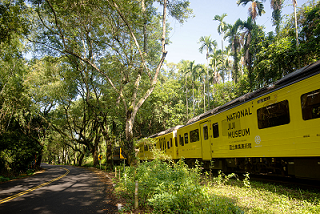
A train runs along a road with a beautiful tree tunnel in Jiji Township, Nantou County.
Issues and conflicts on road development plans in Taiwan generally stem from a lack of transparent information, adequate communication and participation from the public. Taking the development project of Provincial Highway No. 9 as example, it took one year of communication and negotiations between local NGOs and the construction company. Every household in each village was visited and consulted on the matter, and a workshop was held to hear out the thoughts of the local residents. Many residents participated in the arduous, long, yet meaningful process.
Liu stated that "in public construction projects, what we fear the most are those who do not express their thoughts at the beginning." "The general public usually prioritizes harmony over conflicting opinions, especially those living in rural areas—which often have power struggles among different parties. So, in order not to offend anyone, most people choose to remain silent, but this often sacrifices public interest and leaves key decisions in the hands of the minority who hope to manipulate the situation. And as a result, our future generations have to pay for the price."
Ho Chen Tan said that the development of Provincial Highway No. 11 in eastern Taiwan is a painful example. The trees on the highway were all cut off, the road was widened and turned straight, and the driving speed has increased. But, the relationship between neighbors and community members has also been distanced, and with wider roads that lead to high-speed driving, dangers and accidents have also increased. The highway has become one of the most dangerous roads. Ho Chen Tan also thinks that building roads should not focus only on the opinions of experts in the construction field, but should also take into account the needs of the local residents as well as suggestions from environmental experts. Only when different parties communicate and exchange can road construction and rural development reach a win-win situation.
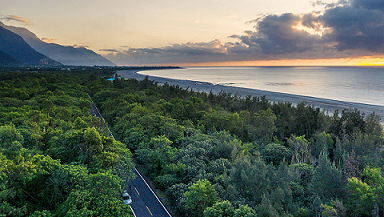
County Road No. 193 runs between mountains and the coast. The trees on both sides of the road have long been a barrier that protects the island from typhoons coming from the east. The road's beautiful landscape is in danger of being altered as the local government hopes to widen the road.
Deng Wen-guang (鄧文廣), Chief Engineer at the Directorate General of Highways of the Ministry of Transportation and Communications, said that the traditional mindset for constructing roads was blasting roads through mountains, setting up bridges to cross waters, and of course, removing large trees when they were in the way. But his involvement in the widening project of Provincial Highway No. 9 made him realize that building roads can create economic, environmental, and social benefits at the same time. After the government of the Republic of China retreated to Taiwan in 1949, transportation infrastructure, which indicated development, was widely built throughout Taiwan. For 70 years, Taiwan's network of roads has become one of the densest in the world, especially in the western Taiwan where the economy first flourished. In the name of economic development and welfare of the people, the natural beauty of Taiwan has given way to a dense network of roads. Convenience throughout the island arrived at the cost of the fragmentation of natural habitats.
A scenic road between mountains and the sea
In the past, Taiwan's road building projects lacked overall planning which led to wrong decisions that didn't address key issues. On an island full of north-south and east-west roads, there is no more necessity to build new roads to address traffic flow or road safety.
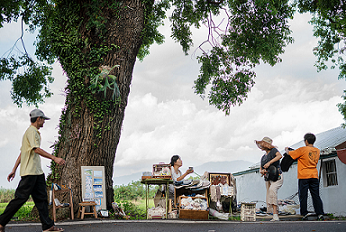
By a road lined with large trees in Taidong, people visit a farmer's market on a Saturday afternoon.
On the conflicting opinions whether County Road No. 193 in the east coast—a lovely road between mountains and the sea—should be widened, Liu said that if we take into consideration the area's road network, we'll find that Provincial Highway No. 9 which runs parallel to it has already been widened. So, there is really no need to further expand the small county road.
Professor of National Dong Hwa University's Department of Natural Resources and Environmental Studies Tai Hsing-sheng (戴興盛) said that the fate of County Road No. 193 also depends on the local residents' vision for the future of Hualien. Do the local people believe that wide, straight, and four-lane roads will truly bring better development to the area? Or do they see the natural landscapes and a relaxed pace of life as invaluable assets of their land?
Cyclers consider County Road No. 193 as a wonderful road for a great cycling experience in Taiwan. From the north, it runs along the eastern coast before coming closer to the mountains of the east coast. The road passes through winding mountain sections, farms, rice fields, and indigenous tribes, offering unique sceneries throughout the four seasons. If the county road is widened and straightened to become a four-lane road, a unique road nestled between the sea and the mountains will disappear.
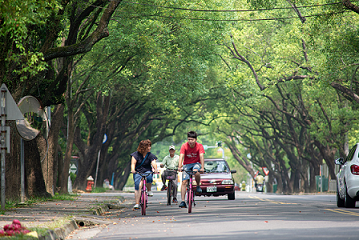
Bikers enjoy the shade under the trees lined by a road.
Our perspective shapes the world we live in. Wen said, "If we look at a river only from the speed in which it flows and the quantity of water that passes through it, overlooking the natural and recreational spaces that it creates, the river will always be just a river. Similarly, if we look at a road only from its traffic flow and transportation functions without looking at other elements in the surrounding environment, then a faster driving speed is indeed better." But, is this how we want to see our roads and trees?
Poetically beautiful are the landscapes of roads lined with trees, which will always bring us natural wonders and lovely company on our journey.
Contact Us | Plan a Visit | Donate
8 Lide Road, Beitou 11259, Taipei, Taiwan
886-2-2898-9999
005741@daaitv.com
©Tzu Chi Culture and Communication Foundation
All rights reserved.
